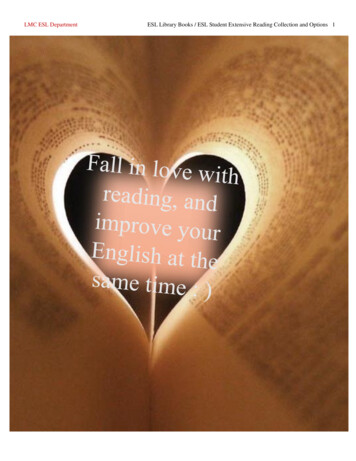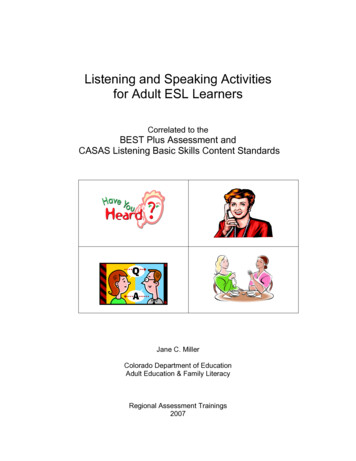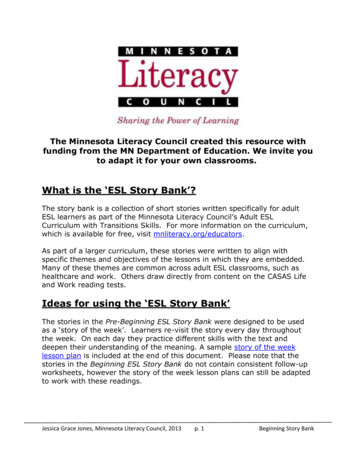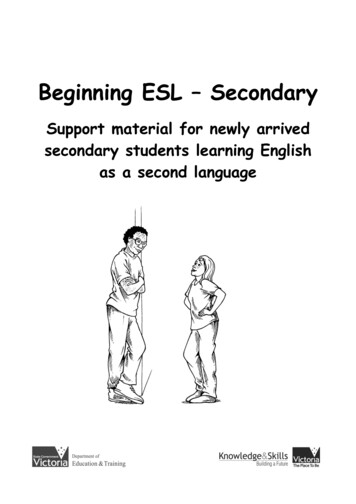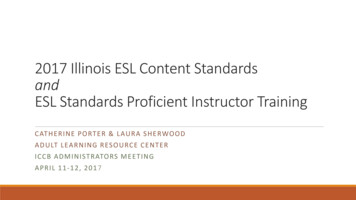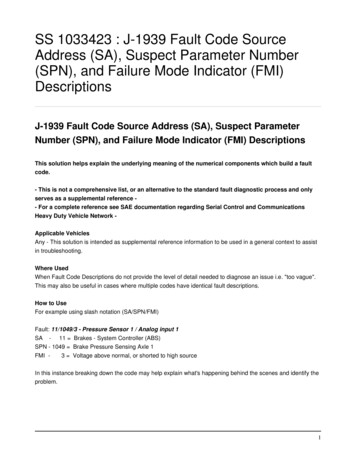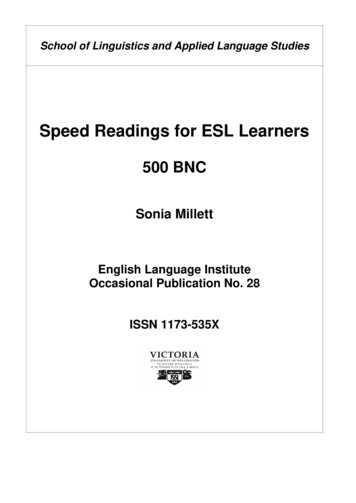
Transcription
School of Linguistics and Applied Language StudiesSpeed Readings for ESL Learners500 BNCSonia MillettEnglish Language InstituteOccasional Publication No. 28ISSN 1173-535X
Speed Readings for ESL Learners500 BNCSonia MillettEnglish Language Institute Occasional Publication No.28ISSN 1173-535X2017
School of Linguistics and Applied Language StudiesVictoria University of WellingtonPO Box 600WellingtonNew Zealandhttp://www.vuw.ac.nz/lalsTo order copies please visit www.vicbooks.co.nzEnglish Language Institute Occasional Publication Number 28ISBN 978 0 475 10525 7 Sonia Millett2017Teachers and staff of the English Language Institute at Victoria University of Wellingtonhelped to proofread and trial these readings and gave valuable feedback and suggestions.The material contained in this book may be photocopied, provided that it is not sold at aprofit and that its source is acknowledged.
IntroductionSpeed Readings for ESL Learners 500 BNC was written at the School of Linguistics andApplied Language Studies at Victoria University of Wellington, New Zealand. Theprogramme contains twenty 300 word passages, each with eight comprehension questions.The readings are world stories and are written within the British National Corpus 500 (VPKids) most frequently used words of English. Exceptions are words that are explained in thetext, titles of passages, content words like country names and animal names, and somecommon words like television, cell phone and internet.Principles of a speed reading programmeA speed reading programme should isolate the skill that is being practised which isincreasing the speed of a student’s reading. It is important not to confuse the purpose ofthe exercise with increasing vocabulary, improving reading comprehension or anything else.A speed reading programme is only a small part of an overall reading programme and whilesuccess with the programme may lead to benefits such as increasing confidence and theeffectiveness and enjoyment of reading, the focus is speed.1.The focus is speed. While reading without understanding would be pointless,the goal of speed reading is not to achieve perfect accuracy in answering thequestions. If students are getting all the answers right, they are reading too slowly.The goal is the fastest time with about 70 percent accuracy.2.The readings should be easy. There should be very little unknown vocabularyand the grammar should be straightforward. There should be nothing to stop thereaders in their tracks. Similarly the questions should test general understandingrather than detailed knowledge. Questions about specific details slow down reading.3.The method of reading is important. Students should not use their fingers orpens to trace the words as this encourages slow word-by-word reading. By readingquickly, students are training their eyes to process meaning chunks.4.Gaining confidence is an important aspect of the programme. A lot oflearning is getting past the ‘I can’t do it’ barrier. A speed reading programme canpush the student through this barrier. Teachers can help by setting individual andclass goals and time limits. Success in speed reading engenders confidence, andconfidence leads to enjoyment, motivation and more success. The virtuous circle.(Nuttall, 1996).5.A speed reading programme should be intensive. Complete the twentyreadings by doing one every day for four weeks.6.Speed reading should be an isolated activity. Don’t plan a follow up activitywith the readings. When students realise they will be doing a follow-up activity, theywill concentrate on comprehension and slow down.i
7.Recording the time and score is important as seeing daily progress is a veryeffective motivator for students. It is also a good way for the teacher to monitorprogress, give feedback and encouragement, and set individual and class goals.Instructions for teachersPhotocopy class sets of the readings. These can be put into plastic sleeves to prolong life.The readings can be done in any order so that it is not necessary for all students to beworking on the same reading. You could make a few sets and then have students choose areading they haven’t done yet.Introduce the programme to the class by explaining the procedure and the reasons fordoing a speed reading programme:Over the next month you will be doing a daily speed reading exercise which involvesreading a short passage and answering 10 comprehension questions.Speed reading is only one of the many ways that the class will be studying reading.The focus of the speed reading programme will be to increase reading speed.Accuracy in answering the questions is not the main consideration. Aim for thefastest time with about 70 percent accuracy.Reading quickly is an important skill for native and non-native speakers and mostpeople can double their reading speed with practice (Nation, 1991). This skill will benecessary at university to cope with heavy reading requirements and for tests. Inaddition, the faster you read, the more effective and enjoyable it will be. Researchsuggests that an improvement in reading leads to benefits across all other languageskills. An example is the Fiji book flood (see Elley & Mangubhai, 1979).The passages are all 300 words long and the vocabulary is controlled and thepassages and questions are not supposed to be difficult.While reading, don’t use a pointer or your finger to trace each word because this willmake you read slowly word-by-word. Try to read in meaning chunks.Answer the questions from memory. Don’t turn back and look at the passage.ii
Instructions to students1. Give out the answer sheet and the graph for recording times and comprehension scores.2. Display an online stopwatch so that students can time themselves.3. Give out the readings and say START.4. Students read as quickly as they can.5. When they reach the end of the passage, they look up and note down their time.6. They then turn over the paper and answer the questions without turning back to the passage.7. When they finish answering the questions, they check their answers.8. They record their time and comprehension score on the graph.As students finish recording their times and scores on their graphs, the teacher can walkaround to check progress and collect the readings. If a student is scoring 8, 9 or 10 on thecomprehension questions, encourage them to read faster next time. You can set individualgoals by drawing a line on a student’s graph.After about half the readings have been completed, it is time to start reducing themaximum time allowed from 3 minutes to 2.50 to 2.40. While many students will already bereading more quickly than this, there will be some who take as long as they are given andthese students can be helped to push through the barrier. If a student does not finishreading the passage in the time allowed, they should still turn over and try to answer thequestions. Their goal is to finish in the time allowed the next day.Once students see their graphs going up, they are motivated to read faster each day. Bylooking across to the right-hand side they can see their words per minute. If a studentmakes no improvement in time and continues to score below 6 correct answers, this is asignal to the teacher that they need additional reading help.Speed Reading BookletsAsian and Pacific Speed Readings for ESL Learners (1000)New Zealand Speed Readings for ESL Learners 1000 Word ListNew Zealand Speed Readings for ESL Learners, Book One (2000)New Zealand Speed Readings for ESL Learners, Book Two (2000 plus AWL)Speed Readings for ESL Learners 500 BNC (World stories)Speed Readings for ESL learners 3000 BNC (General topics)Speed Readings for ESL learners 4000 BNC (General topics)Available from: http://www.vicbooks.co.nz a-millettiii
A model of a daily fluency programme incorporating speed readingsA daily fluency programme attends to the fluency component of Nation’s four strands of asuccessful English programme (2007). Students use and practise the four skills of English:writing, speaking, reading and listening, by accessing the language they have stored in theirheads. The focus is fluency so feedback on accuracy is not given.Each student buys a small exercise book (ideally size 1B4). They tape the speed readinganswer key and graph to the inside back cover for daily use. They bring the exercise book toclass every day and the teacher collects it once a week.1. QuickwriteFive to ten minutes writing on a topic generated by the students with emphasis on fluencyand flow of ideas. The goal is to write as much as possible without the use of an eraser ordictionary. Students write in the back of their journals. The topics might include: myself, myfamily, my home town, my best friend, weather, cats, studying English, a graded reader, amedia story, independent study and so on. The topics start at a very easy level and becomemore sophisticated over the course of the programme. The students demonstrate anincreasing willingness to tackle any topic.2. QuickspeakThree to five minutes of speaking without pauses to a listening partner on the quickwritetopic. Then students change roles. It is good to number off students to form pairs as thisensures a different partner every day. It is also a good idea to have the students stand upwhile they are speaking. They should be speaking as fluently as they can and they shouldn’tbe reading their quickwrites.3. QuickreadSpeed reading4. QuicklistenEach day students listen to a chapter (five to ten minutes) of the audio recording of a gradedreader and simultaneously answer quick questions. Examples of quicklistens and worksheetsare available from illettThese activities should take about 40 minutes and may be combined with a weekly fluencyjournal depending on the level and needs of the students.5. Fluency JournalsStudents write three pages of free writing every week. They are encouraged to treat theirjournals as a quickwrite exercise and take not more than 20 minutes per page. Topics can beset by the teacher or students can choose their own topics. Examples might be: one pageabout their independent learning, one about their extensive reading and the third page ontheir own topic. It can be helpful to start the programme with a brainstorm of possibletopics. Journals are collected once a week, read and commented on for content, notaccuracy, by the teacher and returned to students.iv
Speed Readings for ESL Learners 500 BNC1. Peach Boy2. How Māui slowed the sun3. The tortoise and the hare4. The king’s new clothes5. A man, his son and a donkey6. The Christmas presents7. Stone soup8. The boy who cried wolf9. The 1001 nights10. The fox and the crow11. Tom and the fence12.The rat catcher13. The man who worried too much14. Going home15. Ondal and the kings daughter16. Frida and the animals17. The party18. Where did coffee come from?19.Beautiful men20.The last straw that broke the camel‘s backv
vi
1.Peach BoyA long time ago in Japan, an old man and an old woman lived in a little houseby a river. They were happy except for one thing. They didn’t have anychildren.One day the old man said, “I’m going to cut down a tree for the fire”. The oldwoman said, “I’m going to the river to wash the clothes”.While the old woman was washing the clothes, she saw a big peach comingdown the river. The old woman thought the peach would be very good to eatso she caught it and took it home. When the old people cut the peach open, alittle boy jumped out of the middle. They were happy and they called himPeach Boy.Peach Boy was a happy child and the family lived together for many years. Oneday the old woman said, “Our boy is now a man”.Some bad people lived a long way from the little town. Every year, they cameand took all the money from the people. The people were very scared of them.Peach Boy thought to himself, “I’m going to kill the bad people”. He left homewith some food his mother made for him. On the way he saw a dog. The dogsaid, give me some food and I’ll help you kill the bad people. So he did. Next hesaw a monkey and the same thing happened. Then they saw a bird. Peach Boygave the bird some food and they all started on their way to find the badpeople.When they got there, the bad people fought hard, but the four friends werevery smart and in the end, they killed them all. The friends took all the moneyback to the people and everyone was happy.1
1.Peach Boy1. The old people lived in a:5. Who made the food for PeachBoy?a. little houseb. big housec. a very big housea. His motherb. His fatherc. His mother and father2. They were unhappy about:a. one thingb. two thingsc. many things6. Peach Boy saw:a. a bird and a dogb. a dog and a monkeyc. a bird, a dog and amonkey3. The old woman was washing:a. her handsb. clothesc. children7. What did the bad peopletake?4. She saw a big:a. appleb. peachc. fisha. Animalsb. Childrenc. Money8. How many friends fought thebad people?a. 2b. 4c. 62
2.How Māui slowed the sunOne day, Māui and his brothers were making their food. Then everything wasblack because the sun went away. They couldn’t see what they were doing.Māui was not happy. He said “Why does the sun move so fast? We don’t havetime in the day to do all our work. I’m going to catch the sun and teach it howto go across the sky slowly”.His brothers said he couldn’t catch the sun because it was too big and too hot.Māui said “I have done many hard things and I can do this thing too.” Thepeople thought about this and they all said they would help him.The next day all the people made a lot of big ropes. Then they started to go towhere the sun first gets up in the morning. After 12 days they saw a very bighole in the ground. It was night and they saw that the sun was sleeping in thehole. They got the ropes and said, “Soon we will catch the sun and make itslow down.”The next morning, when the sun tried to climb up into the sky, all the peoplecaught it in the ropes and wouldn’t let it go. The sun was very hot and veryunhappy but Māui told the sun to slow down. At first the sun would not slowdown and tried to go faster, but in the end, Māui hit it with his stick manytimes and the sun slowed down. The sun went slowly up into the sky and fromthat day the sun moved slowly across the sky and the days were longer. Thepeople had time to do all their work and they were happy.This is the story of how Māui slowed the sun.3
2.How Māui slowed the sun1. Who were making food?5. They made:a. The womenb. The menc. Everyonea. a lot of ropesb. a lot of sunsc. a lot of food2. What went away?6. How many days did it take tofind the sun?a. The sunb. The peoplec. The fooda. 6b. 12c. 183. The sun:7. They found the sun:a. moved too slowlyb. didn’t movec. moved too fasta. in the skyb. in the waterc. in a hole4. Who helped him?8. In the end, the days were:a. Some peopleb. All the peoplec. Nobodya. longerb. shorterc. the same4
3.The tortoise and the hareMany years ago there was a very fast hare. His name was Hare. Hare wasalways talking about how fast he could run. He talked about himself so muchthat all the other animals got tired of his talking.There was a very slow tortoise too. The tortoise’s name was Slow and Steady.One day Slow and Steady got tired of Hare’s talking and said to him, “Let’shave a race.” Then Hare said, “How can you run faster than me? I am thefastest animal. It will be nothing for me to win the race.” Slow and Steady said,“I will do my best.”On the day of the race, all the animals came to watch. They were interested tosee who would win the race.Hare and Slow and Steady stood in line and somebody said, “Go!”Hare started running very fast. He ran hard and soon he couldn’t see thetortoise. After a short time, Hare started to get sleepy so he stopped. He saidto himself, “I can run much faster than Slow and Steady. I’m going to have asleep.” He lay down and went to sleep.Slow and steady walked and walked. She walked and walked and she neverstopped walking until she got to the end of the race. All the animals were veryhappy. They ran to Hare and said, “Get up! Get up!”Hare got up and started running, but he was too late. Slow and Steady hadalready won the race.Hare was very unhappy and said to himself, “I will never talk about how fast Ican run again.”This story tells us that slow and steady wins the race. This means that if youkeep going and never give up, you will do what you want to do.5
3.The tortoise and the hare1. The story happened:5. Who said they would have arace?a. 2 years agob. 10 years agoc. many years agoa. Hareb. The tortoisec. The people2. Who talked and talked all thetime?6. After Hare ran for a shorttime, he started to get:a. Hareb. Slow and Steadyc. Another animala. happyb. hungryc. sleepy3. Hare could run:7. Who was unhappy?a. not very fastb. very slowlyc. very fasta. Slow and Steadyb. Harec. The people4. The tortoise could:8. The story means:a. run fastb. run slowlyc. not runa. run fastb. have a sleepc. never give up6
4.The king’s new clothesA long time ago, there was a king who loved to have beautiful new clothes.Every day he wore different new clothes and he used all his money to buy newclothes.One day two bad men came to the town. They saw how much the king lovedclothes and they thought they could get a lot of money. They told the king thatthey could make very beautiful clothes. Not only were the clothes beautiful,but they were magic too. The magic was this. Only good people could see theclothes. Bad people could not see them.The bad men could not really make magic clothes and they didn’t make anyclothes at all. But, the king thought they were telling the truth. He was veryhappy. He thought to himself, “This is very good. Now I can find out which ofmy people are good and which of my people are bad”.The two bad men said they were working very hard day and night. They alwaysneeded more money to buy everything for the magic clothes.After many days of waiting, the clothes were done. But when the bad menshowed the king his new clothes, he couldn’t see anything.“Oh, no, this is not good!” he thought to himself. “I really am a very badperson.”But he didn’t want anyone to know he was a bad person so he said, “Oh, mynew clothes are very beautiful!”Then the king had to put on his beautiful new clothes and go and talk with allhis people. First, all the people said how beautiful the clothes were. Then avery little girl called out. “The king isn’t wearing any clothes.” Then everyonestarted calling out, “The king hasn’t got any clothes on.”And they were right.7
4.The king’s new clothes1. The king didn’t like:5. How long did it take to makethe clothes?a. new clothesb. old clothesc. beautiful clothesa. One dayb. Two daysc. Many days2. How many bad men came totown?6. What did the people saywhen they first saw his newclothes?a. Oneb. Twoc. Threea. They are beautiful.b. They are new.c. Nothing3. They said, the clothes were:a. beautifulb. newc. magic7. What was the king wearingwhen he talked to his people?a. New clothesb. Magic clothesc. No clothes4. If you could not see theclothes you were:a. a good personb. a bad personc. a smart person8. Who called out first?a. A little girlb. The bad menc. All the people8
5.A man, his son and a donkeyOne day, a man and his son were taking their donkey to the town close to theirhouse. They were going to sell the donkey in the town. As they were walking tothe town, a person said to them, “Why don’t you ride on the donkey”. So theman put his boy onto the donkey and they started walking again.Soon, they came to some more people and they said, “What a bad boy! Helets his father walk while he is riding the donkey.” So the man made the boyget down and he climbed onto the donkey’s back and they started walkingagain.Soon they came to some more people who said, “Look at that bad man! Hemakes his son walk while he rides.” The man didn’t know what to do. Afterthinking for a long time he said to the boy, “Get up on the donkey with me.We will both ride to town on the donkey.”When they came to the town, a lot of people saw them and said, “Look atthose big people riding on the back of the little donkey.” So the man and hisson got off the donkey and sat down to think about what to do. At last theythought they would carry the donkey so they got some rope and put it aroundthe donkey’s feet. The man and the boy started to carry the donkey. At thetime they were walking by a river. The donkey was too much for them and itfell into the river and died. Both the man and the boy were very unhappy. Theyhad to go home with no donkey and no money.The meaning of the story: If you try to make everybody happy, you will makenobody happy.9
5.A man, his son and a donkey1. Where was their house?5. Who rode on the donkeynext?a. Close to the townb. Far away from thetownc. Close to the rivera. The man and the boyb. The manc. The boy2. Where were they taking thedonkey?6. Then who rode on thedonkey?a. To the riverb. To the townc. Homea. The man and the boyb. The manc. The boy3. Why were they taking it?7. The donkey:a. To sellb. To ridec. To carrya. swam in the riverb. diedc. was sold4. Who rode the donkey first?8. What is the meaning of thestory?a. The man and the boyb. The manc. The boya. Don’t ride donkeys.b. Don’t carry donkeys.c. Don’t try to makeeveryone happy.10
6.The Christmas presentsA young man and a young woman lived in New York. They were in love andthey got married. The young woman had beautiful long hair. The young manloved her beautiful long hair and every day he looked at it and thought howbeautiful she was.The young man owned an old watch which his father had given him manyyears ago. The young man loved his father’s watch. It was his favourite thing.The young people were very happy but they didn’t have very much money.It was the day before Christmas and the young woman was unhappy becauseshe had no money to buy her man a Christmas present. She knew he loved hiswatch but he couldn’t wear it because the strap was broken.“What can I do?” she thought. After thinking for a long time she said to herself,“I know. I will cut off my hair and sell it. I can get a lot of money for my hair.Then I can buy a new strap for his watch.”She cut off her hair and took it to a woman who bought it. Then she boughtthe watch strap for her man. She went home and waited for him to comehome from work. She didn’t want him to be unhappy when he saw her.She heard the door open and he said “Happy Christmas.” He was verysurprised to see her short hair.They gave each other their Christmas presents. When they saw the presentsthey looked at each other. He had sold his watch to buy a beautiful comb forher hair. She had cut off her hair and sold it to buy a strap for his watch.They were both so happy because they knew how much they loved each other.11
6.The Christmas presents1. They lived in:5. The two young people:a. New Yorkb. Londonc. Tokyoa. were unhappyb. were in lovec. had a lot of money2. The woman’s hair was:6. They had:a. shortb. very shortc. longa. a lot of moneyb. not much moneyc. not much food3. The young man owned:7. When he saw her short hairhe was:a. a dogb. a lot of moneyc. a watcha. happyb. unhappyc. surprised4. Who gave him this thing?8. In the end, they were both:a. very happyb. very unhappyc. very hungrya. His motherb. His fatherc. His brother12
7.Stone soupA long time ago, two friends were walking to the next little town. They hadbeen walking and looking for work for a long time. It was hard to find work inthose times. They were hungry and they didn’t have any money or any food.They were tired and they didn’t have a place to sleep.At night, they came to the little town but they couldn’t see any people. All thepeople of the town were sleeping in their beds. The two friends found a placein the middle of the town and lay down and went to sleep. In the morningthey were very hungry so they took out their cooking pot, and put water into itand put it on the fire. They put some stones in the cooking pot and theywaited. Soon the people of the town got out of their beds and came outside.They looked at the two people and their fire.“What are you cooking?” someone asked.“Stone soup” they said. “It will be very good, but . . . it would be better if it hadsome chicken.”One of the women said, “I’ve got some chicken.” And she ran to her house toget it. The two friends put the chicken into the soup and then they tried a littleof the soup.“Much better.” They said. “But . . . it would be better if it had some potatoes.”Someone said, “I’ve got three potatoes”, and ran off to get the potatoes.Slowly all the people thought of something they could put into the soup andthey all ran back to their houses to get more food.In the end, there was soup for all the people of the town as well as the twohungry happy friends.13
7.Stone soup1. How many friends werewalking?5. In the morning, they were:a. tiredb. hungryc. happya. 1b. 2c. 36. What did they put in theircooking pot first?2. What were they looking for?a. Workb. A townc. Soupa. Chickenb. Waterc. Potatoes3. How many people did theysee in the town that night?7. They were making:a. potato soupb. chicken soupc. stone soupa. A lotb. Not manyc. None8. Who ate the soup?4. They slept:a. The two friendsb. The people of the townc. The two friends and thepeople of the towna. in the middle of thetownb. outside the townc. by a river14
8.The boy who cried wolfA long time ago, there was a boy. His work was to look after the sheep everyday. All the children had to look after the sheep every day. This boy reallydidn’t like his work because all day long, he had to sit and watch the sheep. Ifhe didn’t watch them, they ran away and got lost. Day after day he sat andwatched the sheep. He thought, “I want something interesting to happen tome. I’m tired of doing the same thing every day.”One day he thought to himself, “I know what I’ll do. I’ll tell all the otherchildren that I can see a very big wolf, and I’ll say that the wolf is going to eatmy sheep.”He stood up and cried out, “Help! Help! There is a big wolf and it’s going to eatall my sheep”. All the other children left their sheep and ran over to help theboy. But there was no wolf. The other children were very angry with him. Theysaid, “Don’t tell lies.” They went back to look after their sheep.The next day, the same thing happened. “Help! Help!” cried the boy. All theother children ran to him as fast as they could. Again they saw that the boy hadtold them a lie. There was no wolf.The next day, the boy was sitting looking at his sheep. He looked up and saw abig hungry wolf running at him.“Help! Help!” he cried out. “There is a wolf and it is going to eat me!”He called and called but nobody came. They all thought he was telling liesagain.The wolf ate the boy and that is the end of the story.The meaning of the story is: Don’t tell lies!15
8.The boy who cried wolf1. Who had to look after thesheep?5. They were:a. unhappyb. angryc. hungrya. Boysb. Girlsc. Boys and girls6. On the third day, the boysaw:2. The boy:a. liked his work a lotb. liked his work a littlec. didn’t like his worka. a wolfb. a lot of angry childrenc. a lot of hungry sheep3. Every day he did:7. Which is right?a. different thingsb. the same thingsc. new thingsa. The wolf ate thechildren.b. The wolf ate the sheep.c. The wolf ate the boy.4. The first time, the children:8. What is the meaning of thestory?a. helped himb. didn’t help himc. didn’t hear hima. Don’t help people.b. Don’t eat sheep.c. Don’t tell lies.16
9.The 1001 nightsA long time ago there was a king and queen in Arabia. For some time, theywere happy but one day the queen ran away with another man. The king wasvery angry. He caught the queen and the man and killed them both. After that,he married a different woman every day. The next day she was killed, and hemarried another woman.He had killed 1000 woman before he found Scheherazade. At first, her fathersaid, “No. You will not marry the king because the next day you will die and Iwill never see you again.” But Scheherazade was a very smart woman. She saidshe would stay with the king for one night.When that night came, she asked the king if her sister could stay with thembecause she wanted to say her last goodbye to her and to tell her a story. Theking said yes.That night, Scheherazade, started to tell her story. It was a very interestingstory and a very long story. The king and her sister listened all night, but thenthey saw it was morning. Scheherazade stopped before she got to the end ofthe story. The king said, “Please don’t stop your story”, but she said there wasno time because the king had to kill her.The king really wanted to hear what happened at the end of the story so hesaid he wouldn’t kill her until the next day. That night Scheherazade told theend of the first story, and started the second story. By morning, she had onlytold half the story so the king had to let her live for another day.After 1001 stories and 1001 nights, the king fell in love with Scheherazade andthey lived happily together for many years.17
9.The 1001 nights1. The king and queen were in:5. Why did Scheherazade reallywant her sister to stay withthem?a. Arabiab. Francec. Japana. To say good byeb. To help her start herstoriesc. Because she was scared2. At first, they were:a. unhappyb. happyc. angry6. The first night, she told:a. half a storyb. one and a half storiesc. two and a half stories3. The king killed:a. the queenb. the manc. the queen and the man7. Why did she stop telling thestory?a. It was morningb. They were sleepingc. The king killed her4. How many woman did he killbefore he knewScheherazade?a. 100b. 1,000c. 10,0008. In the end, the king:a. fell in love withScheherazadeb. fell in love with hersisterc. fell asleep18
10. The fox and the crowOne morning, a fox was walking through the trees looking for something to eatfor her breakfast. She was very hungry but
Speed reading is only one of the many ways that the class will be studying reading. The focus of the speed reading programme will be to increase reading speed. Accuracy in answering the questions is not the main consideration.
